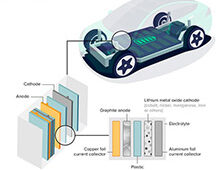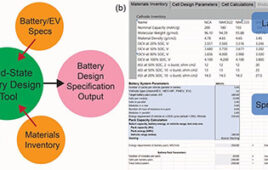Researchers from Case Western Reserve Univ. and the Univ. of North Texas have made what they believe is the first metal-free bifunctional electrocatalyst that performs as well or better than most metal and metal-oxide electrodes in zinc-air batteries.
Zinc-air batteries are expected to be safer, lighter, cheaper and more powerful and durable than lithium-ion batteries common in mobile phones and laptops and increasingly used in hybrid and electric cars.
This carbon-based catalyst works efficiently in both the oxygen reduction reaction and oxygen evolution reaction, making the battery rechargeable. The catalyst is also inexpensive, easy to make and more ecological than most of the alternative materials.
The research is in the online edition of Nature Nanotechnology.
“With batteries, cost is always an issue and metal-free catalysts can reduce cost while improving performance,” said Liming Dai, professor of macromolecular science and engineering at Case Western Reserve Univ. and senior author of the study. “These batteries could be used in computers, data stations, for lighting—anyplace batteries are used now.”
Dai worked with Case Western Reserve postdoctoral researcher Jintao Zhang, who performed experimental work; and North Texas Univ.’s Zhenhai Xia, professor of materials science and engineering, and Zhenghang Zhao, a PhD student, who performed theoretical simulations.
Zinc-air batteries mix oxygen from the air with zinc in a liquid alkaline electrolyte to create a charge. The batteries can have three times the energy density of lithium-ion batteries, but have been sluggish. To counter that problem, researchers are seeking different catalyst materials.
This catalyst is a stable carbon aerogel, or foam, with pores ranging from 2 to 50 nm in diameter, providing enormous surface area and room for the battery electrolyte to diffuse.
The researchers followed a foam-making procedure published by Stanford Univ. scientists in 2012. They polymerized molecules of the organic compound aniline into long chains in a phytic acid solution, then freeze-dried the 3-D hydrogel into an aerogel.
“What we did that’s new is carbonized the 3-D structure, changing it into a graphitic carbon material,” Zhang said.
To do that, the researchers heated the aerogel to 1,000 degrees Celsius in the absence of oxygen. The process, called pyrolysis, caused a thermochemical reaction, turning the foam into a graphitic network, with many graphene edges that proved to be crucial to catalysis.
“This is a low-cost, one-step, scalable process,” Dai said. “The electrocatalyst produces comparable or better results than more costly materials.”
The aniline infuses, or dopes, the foam with nitrogen, which enhances the oxygen reduction reaction. Phytic acid infuses the foam with phosphorus. “The co-doping of nitrogen and phosphorus enhances both the oxygen reduction and oxygen evolution reactions, as confirmed by the first-principles calculations,” Xia said.
In comparisons, the carbon foam’s performance in a primary, or non-rechargeable, battery and a rechargeable battery matched or surpassed that of expensive platinum/metal oxide-based catalysts. And, it had better long-term stability.
The carbon foam also matched or outperformed most previously reported metal-free catalysts, even recently developed carbon-based catalysts with metals.
Moving forward, Dai’s team has begun to further optimize the process while also investigating other graphitic carbon materials co-doped with different elements for possible use in other energy and environmental technologies.
Dai’s lab previously developed carbon-based catalysts that perform comparably or better than more expensive metal-based catalysts used in alkaline and acidic fuel cells and in dye-sensitized solar cells.
“Maybe it’s time to push for metal-free catalysts in commercial devices,” Dai said.
Source: Case Western Reserve Univ.
ENTRIES OPEN:
Establish your company as a technology leader. For 50 years, the R&D 100 Awards, widely recognized as the “Oscars of Invention,” have showcased products of technological significance. Learn more.




